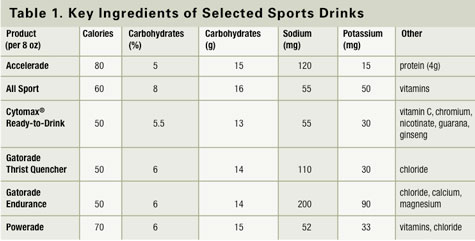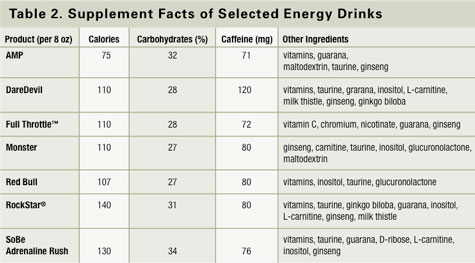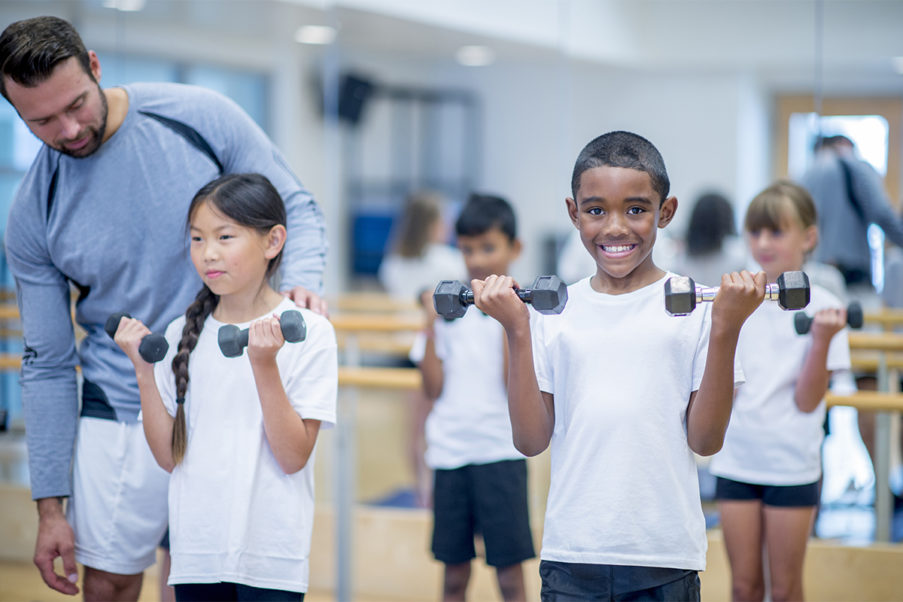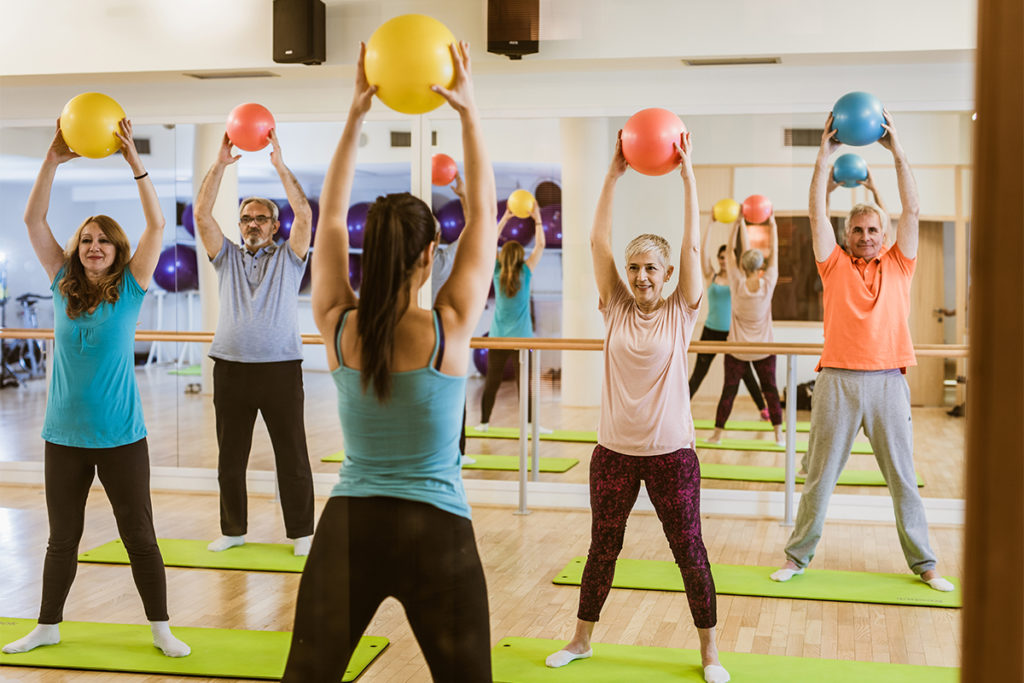Sports & Energy Drinks: Answers for Fitness Professionals
Digest these facts before you take the next swig.

Fitness professionals routinely field questions from clients concerning the use of sports and energy drinks. Sports drinks are designed to be consumed before, during or after exercise. As the name implies, energy drinks have arisen to deliver a proposed “jolt” of energy to a person’s daily life. This article will provide background content, helpful information and contemporary research about sports and
energy drinks.
A Sip of History
The unique origin of sports drinks dates back to the summer of 1965, when a University of Florida “Gators ” assistant football coach asked a team of university physicians (led by Dr. Robert Cade) to determine why the heat was affecting so many of the college’s athletes (www.gatorade.com/history). From their research, the physicians discovered that the players were not adequately replenishing the fluids, electrolytes and carbohydrates lost during practice and competition. The scientists used these findings to formulate a carbohydrate-electrolyte beverage called “Gatorade.” The following year, the Gators went 9–2 and won the Orange Bowl. Other colleges, hoping for similar results, soon began ordering batches of Gatorade, and the sports drink industry was born.
The first energy drink may well have been fashioned in Scotland in 1901 under the name “Iron Brew,” which subsequently changed to Irn-Bru (http://en.wikipedia.org/wiki/Irn-Bru). It is currently advertised as “Scotland’s other National Drink” (referring to Scotch whisky). In Japan, Taisho Pharmaceuticals introduced a drink called Lipovitan D in 1962. It contained
a blend of B vitamins and taurine, ingredients “hypothesized” to bolster energy and concentration (Penalty 2006). Then in 1987 an Austrian named Dietrich Mateschitz furthered this idea by combining sugar and caffeine, formulating Red Bull® (Penalty 2006). The popularity of Red Bull quickly spread in Europe, and a decade later the product arrived in the United States. Today, energy drinks are extremely popular, with over 500 brands appearing on the market in 2006 alone (Boyle 2006).
A Swig of Sports Drinks
Since the inception of sports drinks over 40 years ago, the three main goals have
remained unchanged: (1) prevent dehydration, (2) replace electrolytes lost in sweat and (3) provide carbohydrates for use during exercise (Coombs & Hamilton 2000). Table 1 lists selected sports drinks and provides their key nutrition facts. Most commercial sports drinks provide 50–80 calories and contain 14–17 grams (g) of carbohydrate per 8 ounces (oz) (Stover & Murray 2007). This corresponds to a 6%–8% carbohydrate solution, which has been shown to maximize gastric emptying, enhance fluid absorption from the intestine and supply energy to the working muscle(s) (Coombs & Hamilton 2000; Sawka et al. 2007). Electrolyte concentrations found in sports drinks differ based on the manufacturer. Sodium and potassium are added in small amounts to replace losses due to sweating, to conserve fluid in the muscle cells and—in combination with carbohydrates—to improve palatability (Sawka et al. 2007). The flavor, temperature (cooled) and sodium content of these drinks make them very appealing, thus enhancing the total amount of fluid consumed (Coombs & Hamilton 2000). Some sports drink varieties also include protein, vitamins and minerals.
Guidelines for Sports Drinks
Five key points recap the recent American College of Sports Medicine exercise and fluid replacement guidelines (Sawka et al. 2007):
1. To ensure proper prehydration for exercise, clients should drink 5–7 milliliters of fluid per kilogram of body weight at least 4 hours prior to exercise.
2. If needed, clients can eat a lightly salted snack or small meal containing sodium a couple of hours before exercise, to correct any electrolyte imbalances.
3. During exercise that lasts ≥1 hour, clients can use a sports drink to meet their hydration, electrolyte and carbohydrate needs.
4. Clients should consume some carbohydrate energy (food or sports drink) to help fuel ongoing endurance exercise.
5. Those who exercise in a hot, humid environment or are heavy sweaters may benefit from consuming a carbohydrate-electrolyte solution during shorter bouts of exercise.
The amount of carbohydrate needed to maintain blood glucose levels during lengthy exercise sessions typically ranges from 30 to 60 g per hour (Manore et al. 2000; Sawka et al. 2007). To achieve this from a sports beverage, clients would need to consume 2–4 cups (16–32 oz) per hour. Sawka and colleagues suggest that carbohydrate and electrolyte needs could also be partially or totally met by nonfluid sources such as energy bars or gels. The key is to develop a fluid replacement strategy that meets each client’s needs during exercise.
A Gulp of Energy Drinks
As of 2006, the energy drink market had become a $5.7 billion industry (Boyle 2006). With names like AMP, Full Throttle and Cocaine, energy drinks seem to be appealing to a younger population (or those wishing to feel younger). Table 2 provides key nutrition information for selected energy drinks. As noted in the table, caffeine and sugar are the primary ingredients. Additionally, these beverages contain a “cocktail” of supplemental ingredients, such as herbal extracts (ginseng, guarana and ginkgo biloba), amino acids, derivatives (such as taurine and carnitine) and B vitamins.
Clients often have a number of questions regarding energy drinks:
How much caffeine and sugar do energy drinks contain? The amount of caffeine varies but is typically 70–140 milligrams (mg) per 8 oz (Malinauskas et al. 2007). For reference, one cup (6 oz) of coffee contains about 100 mg. In general, most energy drinks contain 25–35 g of sugar per 8 oz. This equates to 6–9 teaspoons of sugar (4 g per teaspoon). However, many manufacturers do offer consumers sugar-free alternatives (Malinauskas et al. 2007). One additional point to note is that a majority of energy drinks consist of two or more servings per container.
Why are energy drinks so popular? Malinauskas et al. (2007) examined the energy drink consumption patterns of nearly 500 college students and found that over half (51%) of those surveyed consumed more than one energy drink per month. Interestingly, the three primary reasons given for consumption were to remedy insufficient sleep (67%), to increase general feelings of energy (65%) and to imbibe the drink with alcohol while partying (54%).
Do energy drinks actually improve
energy? Caffeine, the principal active ingredient in energy drinks, is a central nervous system stimulant and has been used for decades to increase alertness. When given in a large enough dose, caffeine can cause one to feel “energized.” Smit and co-workers (2004) had 271 volunteers perform fatiguing cognitive tasks after consuming an energy drink containing 75 mg of caffeine or a placebo. The researchers commented that “the energy drink showed clear energizing effects compared to a placebo” for up to 90 minutes after consumption.
Can energy drinks improve exercise performance? Few studies have tested the performance effects of using commercially available energy drinks. So far, findings are inconsistent and lacking in meaningful evidence to support improved aerobic or anaerobic exercise performance (Forbes et al. 2007; Pasiakos et al. 2005; Umaña-Alvarado & Moncada-Jiménez 2005). More research is needed in this area, but from the current literature the use of energy drinks to achieve improved exercise performance seems impractical.
Are there side effects to consuming energy drinks? Some factors that determine the effect that energy drinks (primarily caffeine) have on the human body include age, weight, caffeine tolerance, habituation and dose (Sökmen 2008). The high levels of caffeine found in energy drinks can cause nervousness, headaches, increased blood pressure and elevated heart rate. Of the energy drink users studied by Malinauskas et al. (2007), 29% experienced energy “jolts” followed by crash episodes, 22% experienced headaches and 19% reported heart palpitations.
Sports beverages and energy drinks are definitely here to stay. The information presented here should be useful
to fitness professionals in effectively educating clients who wish to make informed decisions regarding the appropriate use of these drinks.
References
Coombs, J.S., & Hamilton, K.L. 2000. The effectiveness of commercially available sports drinks. Sports Medicine, 29 (3), 181–209.
Forbes, S.C., et al. 2007. Effects of Red Bull energy drink on repeated Wingate cycle performance and bench-press muscular endurance. International Journal of Sports Nutrition and Exercise Metabolism, 17 (5), 433–44.
Gatorade. 2008. www.gatorade.com/history; retrieved July 2008.
Irn-Bru. 2008. http://en.wikipedia.org/wiki/Irn-Bru; retrieved July 2008.
Malinauskas, B.M., et al. 2007. A survey of energy drink consumption patterns among college students. Nutrition Journal, 6, 35.
Manore, M.M., Barr, S.I., & Butterfield, G.E. 2000. Position of the American Dietetic Association, Dietitians of Canada, and the American College of Sports Medicine: Nutrition and athletic performance. Journal of the American Dietetic Association, 100 (12), 1543–56.
Pasiakos, S.M., et al. 2005. The effects of a commercial energy drink on repeated high intensity anaerobic cycling performance. Medicine & Science in Sports & Exercise, 37 (5), S42.
Penalty, J. 2006. A brief history of energy drinks. Swindle, 6. http://swindlemagazine.com/issue06/a-brief-history-of-energy-drinks/; retrieved July 2008.
Sawka, M.N., et al. 2007. American College of Sports Medicine Position Stand: Exercise and fluid replacement. Medicine & Science in Sports & Exercise, 39 (2), 377–90.
Smit, H.J., et al. 2004. Mood and cognitive performance effects of “energy” drink constituents: caffeine, glucose and carbonation. Nutritional Neuroscience, 7 (3), 127–39.
Sökmen, B., et al. 2008. Caffeine use in sports: Considerations for the Athlete. Journal of Strength and Conditioning Research, 22 (3), 978–86.
Stover, B., & Murray, B. 2007. Drink up! The science of hydration. ACSM’s Health & Fitness Journal, 11 (2), 7–12.
Umaña-Alvarado, M., & Moncada-Jiménez, J. 2005. The effect of an energy drink on cycling performance in male athletes. Medicine & Science in Sports & Exercise, 37 (5), S38.






